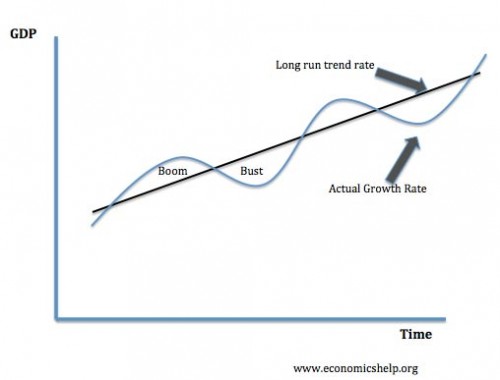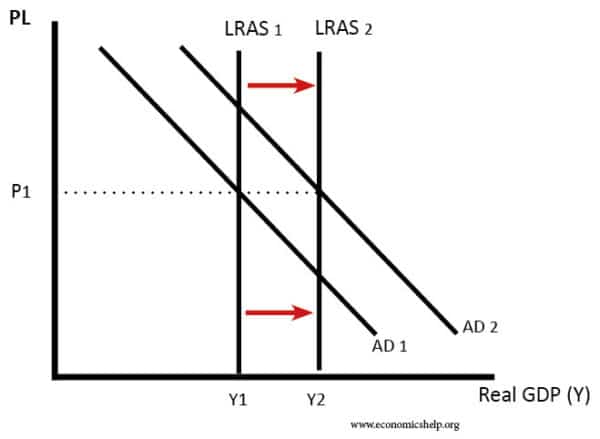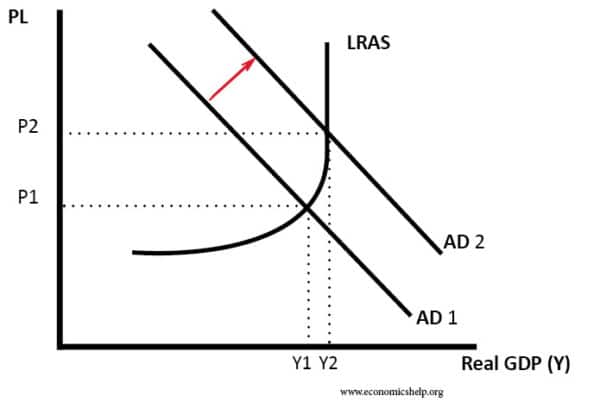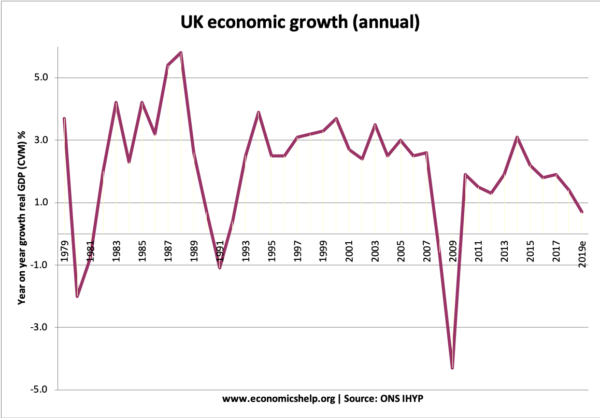Sustainable economic growth implies that the growth rate can be maintained over the long term. Sustainable growth involves both
- Environmentally sustainable growth – e.g. not exploiting scarce resources.
- Sustainable growth in terms of low inflation and a balanced economy.
Sustainable economic growth
The long-run trend rate of economic growth is the rate of economic growth that can be averaged over a sustained period of time – without excess inflationary pressures.

If economic growth is above the long-run trend rate of growth then the economy will tend to experience inflationary pressures. This is because aggregate demand is rising faster than aggregate supply. It will also lead to a deterioration in the current account balance of payments. Domestic firms cannot meet domestic demand, so consumers switch to imports.
This kind of inflationary growth tends to be unsustainable. If long run productive capacity is increasing at 2.5%, but demand is growing at 5%, there is excess demand in the economy. In the short-term firms can pay workers to do overtime, but the boom in demand cannot be maintained in the long term and after a ‘boom’ the economy often falls into recession.
Example of unsustainable growth
In the late 1980s, the UK economy experienced an economic boom with a growth rate of over 4% a year. However, this led to inflation and a large current account deficit. With inflation creeping up to 10%, the government increased interest rates and the boom turned into a deep recession.
Example of sustainable growth

From 1993 to 2007, the UK enjoyed a long period of uninterrupted economic growth with 15 years of positive economic growth. During this period inflation remained low and the growth rate was close to the long-run trend rate. This period could be seen to be sustainable. Though there was also a boom in bank lending and house prices which caused problems during credit crunch.
Environmentally sustainable growth
Environmentally sustainable growth needs to be maintained for not just the long run (several years) but the very long run (several decades/centuries). Environmentally sustainable growth will require
- Limiting the creation of pollution that could harm living standards over time. For example, nuclear power may give cheap energy for the next 50 years, but radioactive waste could harm future generations.
- Growth that doesn’t causes damaging climate change. Excess production of CO2 emissions is contributing to global warming. If global temperatures rise 2 or 3 degrees, it could make large parts of the world uninhabitable. For example, sea levels will rise causing a loss of many low lying areas. Also, it could cause increased desertification of farming land, reducing the ability to feed future generations. Sustainable growth would prioritise limiting CO2 emissions and preventing global warming.
- Protecting non-renewable resources. Growth based on the consumption of non-renewable resources means that the growth cannot be maintained when the non-renewable resources run out. This can include the burning of fossil fuels or loss of bio-diversity which may lead to future vaccines. Also, of critical importance is the quality of topsoil. Modern farming methods have increased productivity and efficiency but at the cost of damage to the topsoil. This could lead to lower agricultural yields over time.
Policies for sustainable growth
- Demand management
- Prioritising environment in the economy.
If economic growth is becoming too fast, the government/Central Bank can slow the growth rate through Monetary/fiscal policy. For example at the start of a boom, the Central Bank could increase interest rates to slow down the rate of consumer spending – in theory – this helps to slow down the economic boom.
Target environmental indicators. For environmentally sustainable growth, the government can target a measure like GPI (Genuine Progress indicator) rather than GDP. GPI looks at the positive side of increasing output but subtracts any environmental or social cost. Being aware of the limitation of GDP can help promote policies which are more environmentally sustainable.
Tax external costs. The consumption of fossil fuel creates external costs such as CO2 emissions and global warming. Taxing carbon emissions creates an incentive for firms to switch to more renewable sources of energy.
Regulations. Rather than leave it to market forces, or even tax/subsidy, a government could ban practises that damage environmental sustainability. For example, banning pesticides that harm bees and banning chemicals which damage the water supply.
Related



Growth: the increased use of resources and production.
Sustainability: using minimal resources.
There is a contradiction here. If we want to decarbonize our economy, why is there so much evidence that even “green” growth can’t work? Where has decoupling worked globally? This is pure delusion by the capitalist cope.